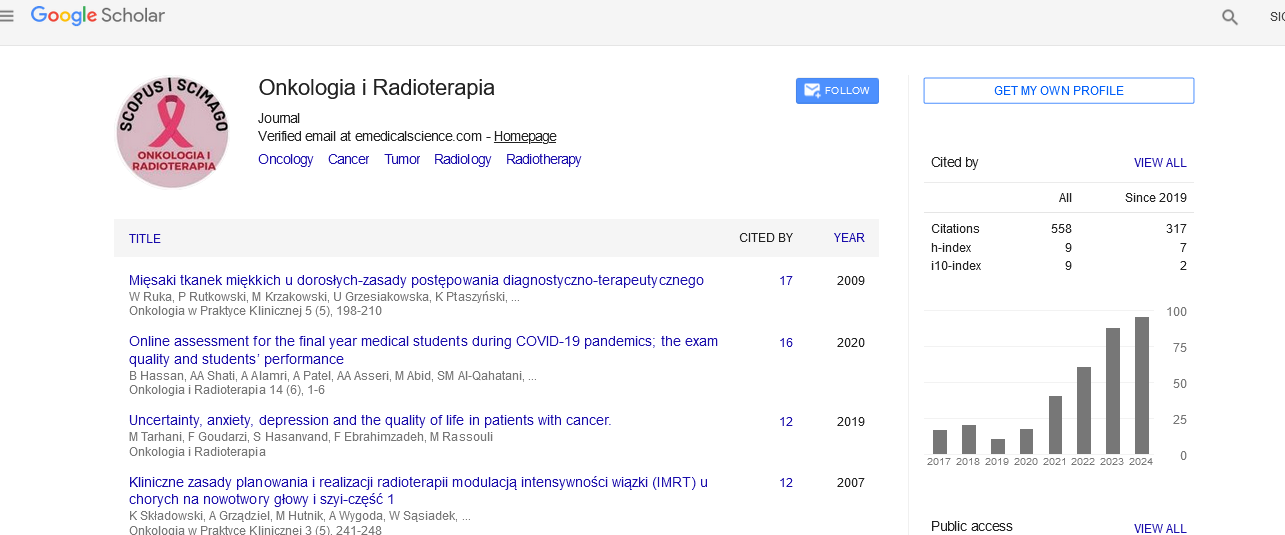Comparison of MatriXX evolution and MatriXX resolution dosimetry systems and their sensitivity to gantry angle variations in gamma index measurements
Abstract
Author(s): El Ghalmi Mohammed, El Mahjoub Chakir, Lakbir El Hamidi, Raoui Yasser*, Herrassi Yassine, Oustous Aziz, Jioudi Bassma, Errouadi Morad, ELOuardy Khalid, Talsmat Khalid and Chouib Fatima Ezzahra
This study investigates the dosimetric performance of two advanced dosimetry systems, MatriXX evolution and MatriXX resolution, using gamma index measurements under fixed and varying gantry angles. The study aims to elucidate the impact of system characteristics and gantry angulation on dosimetric accuracy in radiation therapy quality assurance.
Accurate dose delivery in radiation therapy relies on robust quality assurance measures provided by dosimetry systems. MatriXX evolution and MatriXX resolution are widely recognized for their ability to capture dose distributions, with MatriXX resolution offering higher detector density and spatial resolution compared to MatriXX evolution. The gamma index, a metric commonly used for dosimetric evaluation, quantifies the agreement between calculated and measured dose distributions, crucial for ensuring treatment efficacy and patient safety.
Measurements were performed using the Elekta Infinity LINAC operating at 6 MV and 6 FFF (Flattening Filter Free) modes. Dose distributions were calculated using the Monaco Monte Carlo treatment planning system, simulating clinical scenarios with both fixed gantry angle (0°) and varying gantry angles. Gamma index evaluations were conducted using criteria of 2%/2 mm and 3%/3 mm to assess dosimetric accuracy.
Analysis of gamma index results revealed significant differences between MatriXX evolution and MatriXX resolution. MatriXX resolution consistently demonstrated superior gamma index values, particularly under strict criteria (2%/2 mm), attributable to its enhanced detector density and spatial resolution capabilities. Variations in gantry angle introduced notable changes in gamma index values for both dosimetry systems, highlighting the influence of beam orientation on dosimetric accuracy.
In conclusion, this study underscores the critical role of dosimetry system characteristics and gantry angulation in radiation therapy quality assurance. MatriXX resolution's superior performance over matriXX evolution in detecting small dose discrepancies underscores its suitability for precise dosimetric evaluations. The findings emphasize the necessity of comprehensive QA protocols considering angular effects to ensure accurate radiation dose delivery in clinical practice.
Share this article


Editors List
-
RAOUi Yasser
Senior Medical Physicist
-
Ahmed Hussien Alshewered
University of Basrah College of Medicine, Iraq
-
Sudhakar Tummala
Department of Electronics and Communication Engineering SRM University – AP, Andhra Pradesh
-
Alphonse Laya
Supervisor of Biochemistry Lab and PhD. students of Faculty of Science, Department of Chemistry and Department of Chemis
-
Fava Maria Giovanna
Google Scholar citation report
Citations : 558
Onkologia i Radioterapia received 558 citations as per Google Scholar report
Onkologia i Radioterapia peer review process verified at publons
Indexed In
- Directory of Open Access Journals
- Scimago
- SCOPUS
- EBSCO A-Z
- MIAR
- Euro Pub
- Google Scholar
- Medical Project Poland
- PUBMED
- Cancer Index
- Gdansk University of Technology, Ministry Points 20

